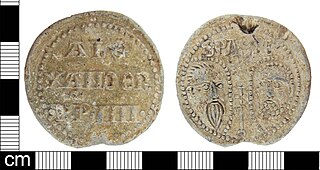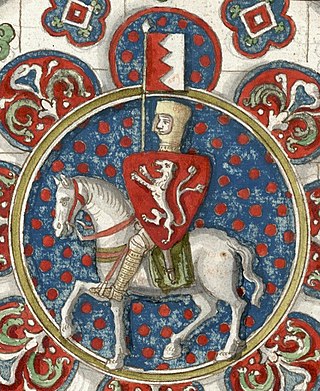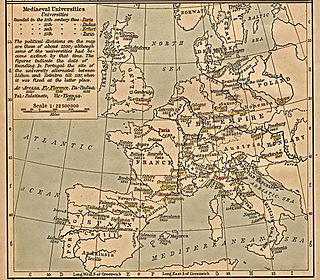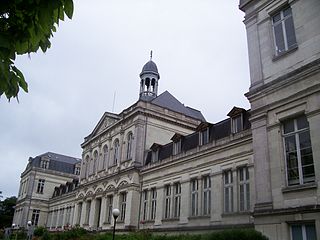
Pope Alexander IV was head of the Catholic Church and ruler of the Papal States from 12 December 1254 to his death.

Pope Gregory IX was head of the Catholic Church and the ruler of the Papal States from 19 March 1227 until his death in 1241. He is known for issuing the Decretales and instituting the Papal Inquisition, in response to the failures of the episcopal inquisitions established during the time of Pope Lucius III, by means of the papal bull Ad abolendam, issued in 1184.

Year 1231 (MCCXXXI) was a common year starting on Wednesday of the Julian calendar.

Pope Eugene IV, born Gabriele Condulmer, was head of the Catholic Church and ruler of the Papal States from 11 March 1431 to his death, in February 1447. Condulmer was a Venetian, and a nephew of Pope Gregory XII. In 1431, he was elected pope.

The Sixth Crusade (1228–1229), also known as the Crusade of Frederick II, was a military expedition to recapture Jerusalem and the rest of the Holy Land. It began seven years after the failure of the Fifth Crusade and involved very little actual fighting. The diplomatic maneuvering of the Holy Roman Emperor and King of Sicily, Frederick II, resulted in the Kingdom of Jerusalem regaining some control over Jerusalem for much of the ensuing fifteen years as well as over other areas of the Holy Land.

The University of Paris, known metonymically as the Sorbonne, was the leading university in Paris, France, from 1150 to 1970, except for 1793–1806 during the French Revolution. Emerging around 1150 as a corporation associated with the cathedral school of Paris, it was considered the second-oldest university in Europe. Officially chartered in 1200 by King Philip II of France and recognised in 1215 by Pope Innocent III, it was nicknamed after its theological College of Sorbonne, founded by Robert de Sorbon and chartered by King Louis IX around 1257.

A medieval university was a corporation organized during the Middle Ages for the purposes of higher education. The first Western European institutions generally considered to be universities were established in present-day Italy, including the Kingdoms of Sicily and Naples, and the Kingdoms of England, France, Spain, Portugal, and Scotland between the 11th and 15th centuries for the study of the arts and the higher disciplines of theology, law, and medicine. These universities evolved from much older Christian cathedral schools and monastic schools, and it is difficult to define the exact date when they became true universities, though the lists of studia generalia for higher education in Europe held by the Vatican are a useful guide.

Robert Kilwardby was an Archbishop of Canterbury in England and a cardinal. Kilwardby was the first member of a mendicant order to attain a high ecclesiastical office in the English Church.
The University of Paris strike of 1229 took place in Paris, France. The strike occurred as a disagreement over an unpaid tab at a local tavern. The ensuing disagreement caused the deaths of several students when the Queen ordered the mercenary bodyguards to punish the student riot. The students protested with a "dispersion", or student strike; the masters suspended lectures. This lasted more than two years and led to several reforms in the medieval university when Pope Gregory IX issued the bull Parens scientiarum. The event demonstrates the town and gown power struggles with the Church, secular leaders, and the emerging student class and a lessening of local Church authority over the University of Paris. The university was placed squarely under direct papal patronage, part of the program to centralize the Church structure, which had intensified under Innocent III.

Jacques de Vitry was a French canon regular who was a noted theologian and chronicler of his era. He was elected bishop of Acre in 1214 and made cardinal in 1229. His Historia Orientalis is an important source for the historiography of the Crusades.

Studium generale is the old customary name for a medieval university in medieval Europe.

Town and gown are two distinct communities of a university town; 'town' being the non-academic population and 'gown' metonymically being the university community, especially in ancient seats of learning such as Oxford, Cambridge, Durham, and St Andrews, although the term is also used to describe modern university towns as well as towns with a significant public school. The metaphor is historical in its connotation but continues to be used in the literature on urban higher education and in common parlance.

Peter of Hispania was the author of the Tractatus, later known as the Summulae Logicales, an important medieval university textbook on Aristotelian logic. As the Latin Hispania was considered to include the entire Iberian Peninsula, he is traditionally and usually identified with the medieval Portuguese scholar and ecclesiastic Peter Juliani, who was elected Pope John XXI in 1276. The identification is sometimes disputed, usually by Spanish authors, who claim the author of the Tractatus was a Castilian Blackfriar. He is also sometimes identified as Petrus Ferrandi Hispanus.

The Catholic University of the West, also known as UCO or colloquially as la Catho, is a university located in Angers, France.
John Halgren of Abbeville was a French scholastic theologian and cleric. He served successively as a university professor, priest, prior, archbishop, cardinal, apostolic legate and diplomat.

Authentica habita, or Privilegium Scholasticum, was a document written in 1155 ca. by the Emperor Frederick I Barbarossa. In it, he set out for the first time some of the rules, rights and privileges of students and scholars. It is an important precursor to the formation of medieval universities in Europe.

Clerici vagantes or vagabundi is a medieval Latin term meaning "wandering clergy" applied in early canon law to those clergy who led a wandering life either because they had no benefice or because they had deserted the church to which they had been attached.

Bertrand de Thessy, also known as Bertrand of Thercy, was the fifteenth Grand Master of the Knights Hospitaller, serving between 1228 and 1230 or 1231. He succeeded Guérin de Montaigu upon his death on 1 March 1228. Thessy was either from France or Italy, most likely the former. He was succeeded by Guérin Lebrun.

The War of the Keys (1228–1230) was the first military conflict between Frederick II, Holy Roman Emperor, and the Papacy. Fighting took place in central and southern Italy. The Papacy made strong gains at first, securing the Papal States and invading the Kingdom of Sicily, while Frederick was away on the Sixth Crusade. Upon his return, he defeated the papal forces, forcing Pope Gregory IX to begin peace talks. After drawn-out negotiations, the treaty of San Germano terminated the conflict with no territorial changes.
Parens are a set of parentheses.

















